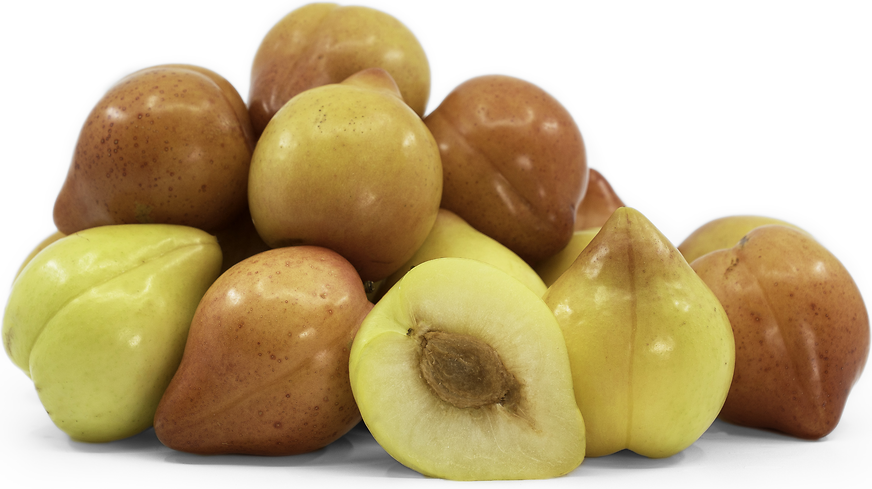


Lemon Plums
Estimated Inventory, 18 lbs : 0
Description/Taste
Lemon plums are small to medium fruits with a distinct oval to round shape, bearing curved shoulders and a tapered, elongated tip on the non-stem end, reminiscent of the shape of a lemon. The skin is thin, smooth, glossy, and taut, showcasing bright yellow hues when unripe. As Lemon plums mature, they develop an orange-red spot at the tip, which eventually covers the entire fruit in an orange blush, later darkening into ruby-red. The fruit’s flesh is firm, crisp, and pale yellow when unripe, softening into a tender, succulent, and aqueous consistency when mature. The flesh’s color will also deepen into an amber-golden hue as it ripens. In the center of the flesh, there is a small, brown, and oblong, inedible pit. Lemon plums are acidic and sour when young. As the fruit matures, the flesh will emit a light, floral aroma and is concentrated with sugars, creating a sweet flavor with subtle, tangy nuances.
Seasons/Availability
Lemon plums are available for a short season in the late winter through early spring.
Current Facts
Lemon plums, botanically classified as Prunus salicina, are a rare variety belonging to the Rosaceae family. The cultivar was originally developed in Israel where it was sold under the name Lamoon plums, roughly translating from Arabic to mean “lemon.” The variety was later licensed to growers in Chile under the name Lemon plum for expanded cultivation and export to North America. Lemon plums were introduced to consumer markets in Canada and the United States in the early 21st century. In the United States, the specialty variety is sold in small quantities and is currently only available for a few weeks in the late winter and early spring. Lemon plums are highly favored for their unique coloring, shape, and sweet, subtly tangy flavor. Despite their name, the fruits do not contain a sour flavor when ripe and received their citrus moniker from their similarity in color and shape to a lemon. Lemon plums are slowly growing in popularity as consumers become aware of the rare fruits, and the plums are primarily consumed fresh to showcase their sweet flavor.
Nutritional Value
Lemon plums are an excellent source of vitamins A and C, nutrients that strengthen the immune system, improve skin complexion, and reduce inflammation. The fruits are also a source of fiber to stimulate the digestive tract and provide lower amounts of phosphate, calcium, and potassium.
Applications
Lemon plums are best eaten fresh and can be incorporated into raw and cooked preparations. When the plums are yellow and unripe, their flesh is firm, crisp, sour, and slightly acidic. Unripe Lemon plums can be sprinkled with salt and eaten as a snack, sliced thinly and tossed into salads, or cooked with sugar into a tangy compote. Crisp Lemon plums also hold their shape and texture in baked applications such as tarts and cakes and can be cooked into jams and jellies. When ripe, the fruit’s flesh softens and develops a sweet taste, popularly eaten straight, out-of-hand. The ripe fruits can also be used as a topping over yogurt, cereal, salads, and grain bowls, blended into smoothies, sliced and served with nuts, cheeses, and other fruits as an appetizer, or mixed with ice cream. Lemon plums pair well with spices such as cinnamon, ginger, nutmeg, and cardamom, nuts such as walnuts, almonds, and pecans, berries, vanilla, and chocolate. Whole unripe Lemon plums should be stored at room temperature to soften and mature. Once ripe, the fruits can be stored in a ventilated plastic bag in the refrigerator for 2 to 4 weeks.
Ethnic/Cultural Info
Lemon plums are also known as the Chameleon plum, named for their unique color changing abilities. The fruits are pale yellow when unripe, sometimes displaying green undertones depending on when the plums were harvested. As the fruits mature, they develop a red-orange blush at the tip, which eventually expands and envelops the entire fruit, transitioning into a ruby red hue. This color change is favorable for commercial markets as it offers consumers a clear indication of when the fruits are ripe and ready-to-eat. Retailers throughout the United States are using this color change as a tool to educate consumers. Signs are placed next to the fruits in store and generally depict three different stages of ripeness for an easy-to-read, clear format. The unique plum variety also has a long ripening time, allowing it to be transported long distances and stored for extended use.
Geography/History
Lemon plums were developed through Ben Dor Fruits & Nurseries, one of the largest stone fruit producers in Israel, located in the northern Hula Valley near the Lebanese border. Within the Lemon plum line through Ben Dor, there are multiple varieties that are seasonally grown in small quantities throughout the year and are localized to Israel. Lemon plums were also licensed to select growers in Chile. When in season, the fruits are exported to the United States and Canada and were first seen in American markets in the early 21st century. There are also a few growers in the United States that have begun cultivating the variety. Today Lemon plums have remained a rare cultivar and are only found for a short season through select retailers and specialty grocers in the Middle East, Chile, the United States, and Canada.
Recipe Ideas
Recipes that include Lemon Plums. One
Podcasts




